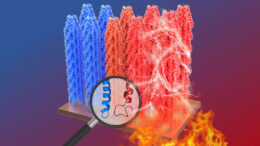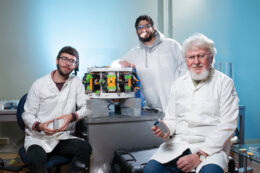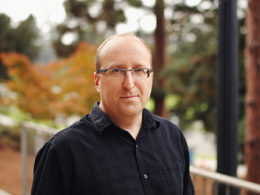Posts Tagged ‘faculty’
So to speak: how bats and humans communicate
Berkeley researchers led by Professor Michael Yartsev, working with scientists at Carnegie Mellon University, have identified the part of the brain in Egyptian fruit bats that controls vocalizations and found that it contains similar neural wiring and genetics to the part of the human brain that controls speech.
Read MorePutting on the heat
Professor Seung-Wuk Lee discusses pyroelectricity: the finding that viruses can generate electricity when exposed to heat, and how this may pave the way for next-generation biosensors and diagnostic tools.
Read MoreCool it down
How isochoric preservation can protect food, organs — and even the planet. Professor Boris Rubinsky discusses the state of the art in cryogenics and preservation.
Read MoreViral Pyroelectricity with Seung-Wuk Lee
Professor Seung-Wuk Lee discusses pyroelectricity: the finding that viruses can generate electricity when exposed to heat, and how this may pave the way for next-generation biosensors and diagnostic tools.
Read MoreYartsev wins Boehringer Ingelheim FENS Research Award 2024
The Federation of European Neuroscience Societies (FENS) has selected Professor Michael Yartsev for the 2024 Boehringer Ingelheim FENS Research Award, given in recognition of outstanding and innovative work from all areas of neuroscience. The award will be presented at the FENS Forum conference in Vienna.
Read MoreLiana Lareau wins Bakar Spark Award
Congratulations to Professor Liana Lareau, winner of a 2024 Spark Award from the Bakar Fellows Program.
Read MoreBakar ClimatEnginuity Hub: Berkeley’s new home for climate innovation
Professor David Schaffer will lead the new Bakar ClimatEnginuity Hub, an incubator that will provide resources and support to entrepreneurs in renewable energy and clean technology.
Read MoreBerkeley’s ecosystem of innovation, entrepreneurship combats climate change
Professors John Dueber and David Schaffer are featured in this article highlighting campus research and entrepreneurship in sustainability.
Read MoreProfessor Teresa Head-Gordon awarded the Humboldt Research Award
Congratulations to Professor Teresa Head-Gordon, who has been honored with a prestigious research award from the Humboldt Foundation, known for fostering collaboration with German scientists.
Read More








